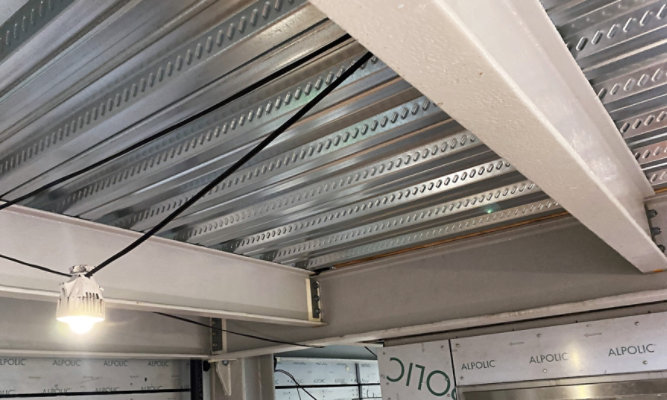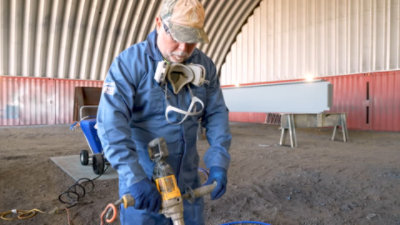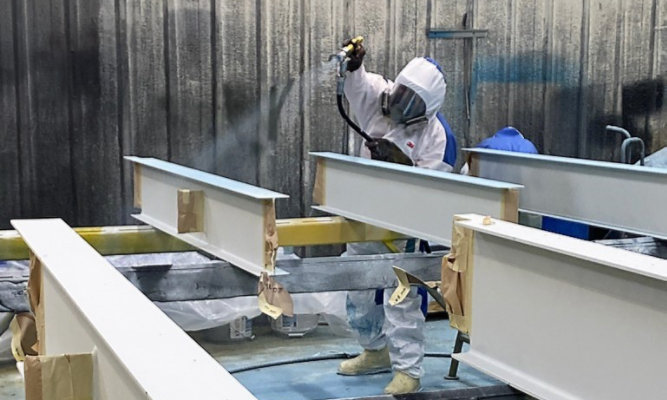Fireproofing for Structural Steel: A Guide to Requirements, Applications, and Materials
by George Guanci, Market Manager – Fire Protection, Sherwin-Williams Protective & Marine
Contact Us for More Information

Buildings and facilities require fire protection on the steel columns, beams or assets to keep the inhabitants of these structures safe. If unprotected steel reaches a certain temperature, it rapidly weakens, which can lead to structural collapse. The purpose of fireproofing is to prevent the steel from heating to a temperature that could cause the steel to fail.
In the case of a fire, providing adequate fire protection to steel helps protect human life as well as the building itself. Additionally, fireproofing prevents the fire from spreading as quickly, allowing people the time to escape from the building and reach safety. Effective fire protection, such as the application of intumescent fireproof coatings, is essential to reducing safety risks, preventing damage and supporting the longevity of a steel structure.
What Is Fireproofing?
Fireproofing is the process of applying protective materials to structures to prevent them from reaching critical temperatures during a fire. For structural steel, fireproofing helps ensure the steel retains its load-bearing capacity for a specific duration, allowing occupants time to evacuate and emergency services time to respond. Fireproofing materials can include cementitious coatings and intumescent coatings that are tailored to the building’s fire protection requirements and aesthetic needs.
Fireproofing not only protects the structural integrity of a building but also minimizes property damage and the spread of fire. By slowing the spread of flames and reducing the risk of structural failure, fireproofing ensures compliance with safety codes, provides peace of mind for occupants and building owners, and ultimately enhances safety during emergencies.
What Structural Steel Requires Fireproofing?
Fireproofing is required for various structural steel elements that play a role in maintaining the stability and safety of a building during a fire. Each type of steel element has unique characteristics and fireproofing needs.
- Steel Beams - Steel beams support the weight of floors and ceilings, making them essential for maintaining the structural integrity of a building. Without adequate fireproofing, beams can lose their strength when exposed to high temperatures, leading to the collapse of supported structures. Fireproofing beams ensures they retain their load-bearing capacity during a fire, buying valuable time for evacuation and firefighting efforts.
- Steel Columns - Columns are vertical load-bearing structures that transfer weight from the roof and upper floors to the foundation. In a fire, unprotected columns can weaken fast, causing a chain reaction of structural failures. Fireproofing columns is crucial to prevent catastrophic collapse and maintain the building’s overall stability.
- Steel Assets - Structural steel assets—such as braces, connectors, and other components—also require fire protection to help ensure the entire framework remains intact. Even small elements compromised by heat can affect the performance of the larger structure. Fireproofing these assets not only enhances the safety of the building but also ensures compliance with fire safety regulations.
By addressing the fireproofing needs of beams, columns, and assets, architects and engineers can create safer buildings that are better equipped to withstand fire-related emergencies.
Building Codes, Ratings and Fireproofing Requirements for Structural Steel
Steel fire protection methods must follow a set of building codes and be formulated to meet the required fire protection rating for that structure.
Steel Fireproofing Certifications
Building codes require that fire protection coating products must be tested and certified to industry standards. Fire testing is carried out to evaluate the insulation properties of steel members, shapes and assemblies in various sizes that are representative of what would be used in an actual construction environment.
Specifically, under the International Building Code (IBC), specifications must list either the ASTM E119 Standard Test Method for Fire Tests of Building Construction and Materials or the Underwriters Solutions UL 263 Standard for Safety Fire Tests of Building Construction and Materials. Both ASTM E119 and UL 263 are commonly specified throughout North America and in other regions as well.
Fire Protection Ratings
To achieve fireproof standards set by local building codes and federal regulations, architects and engineers must use fire protection materials that meet certain levels of fireproofing, which typically fall between one to three hours of fire protection on steel.
The fireproof rating will change depending on a variety of factors, including:
- The height of the building
- The use of the building, and
- How many people are in the building during its normal functioning time.
Steel Fireproofing Options: Cementitious vs. Intumescent Coatings
Two options of steel fire protection coatings include cementitious products and intumescent products.
Cementitious coatings, or sprayed fire-resistant materials (SFRM), improve the fire resistance of steel by creating a thick, durable barrier between the steel substrate and potential fire. This option requires multiple layers to adequately protect the underlying steel. When properly applied, SFRM coatings delay the rate at which flames or high temperatures can transfer to the steel.
Intumescent coatings, or intumescent fire-resistant material (IFRM), are an advanced form of fire protection for steel. Rather than relying on a cementitious barrier to protect the steel from flames like SFRM coatings do, IFRM coatings are applied in a thin layer and expand if exposed to heat. In the case of a fire, intumescent coatings will char and expand, increasing in volume and decreasing in density to slow the transfer of heat to the steel substrate and to prolong the time before significant failure occurs.
Architects and engineers around the globe are turning to intumescent fireproof coatings to protect steel structures, buildings and assets due to their aesthetically pleasing finish, durability, effectiveness and resistance to damage.
Application Methods for Fireproofing Steel
The most common method for applying fireproofing is by spraying. The spray method is the most efficient use of product and time. With this method, you can apply more product per square foot in a time frame as compared to any other application method. In fact, the only time an applicator may not consider spraying is if there are only one or two small beams or columns that need to be fireproofed. In this case, they would apply a product that can be brushed, rolled or trowel-applied.
Advances in fireproofing application methods have also allowed for intumescent, or paint, coatings to be applied off-site. While typically fireproofing is applied when the steel is already erected, in many cases, the applicator can apply the fireproof coating to the steel in a shop and ship it to the job site already fireproofed. This method speeds up the construction cycle and ensures a high-quality, smooth finish due to the higher level of quality control.
Aesthetic differences between smooth intumescent and cementitious fireproofing.
Spray-applying the coating is the most common method of intumescent fireproofing application.
Types of Intumescent Fireproofing Materials for Steel
Among intumescent fire protection coatings, there are three main chemistries: water-based coatings, solvent-based coatings and epoxy-based coatings.
1. Water-Based Coatings
Water-based coatings are the most popular type of intumescent fire protection products. They have the smoothest finish, meet LEED requirements, are low in volatile organic compounds (VOCs) and odors, are easiest to apply and can be cleaned up with water. Thanks to their attractive appearance, water-based intumescent coatings are commonly used on exposed steel.
2. Solvent-Based Coatings
Solvent-based coatings have a more textured finish than water-based coatings. They have better application flexibility with the ability to be applied at lower temperatures and are less sensitive to moisture and humidity. At the same time, these solvent-based coatings have a slight odor during the application process.
3. Epoxy-Based Coatings
Epoxy-based coatings are designed to have extremely strong physical and mechanical properties. They result in a highly durable finish, can withstand more wear and tear and are impervious to most chemicals and acids, making them ideal for buildings and facilities with high levels of traffic and vibrations like subway stations and industrial facilities.
Additionally, while they can be applied in the field, epoxy-based intumescent coatings are excellent candidates for shop-applied fire protection due to their extreme durability – lessening the damage done during transport from the shop to the construction site..
Solvent-Based Coating
Epoxy-Based Coating
Tailored Intumescent Fire Protection for Structural Steel and Buildings
Sherwin-Williams intumescent fire protection coating systems fully adhere to steel, provide long-lasting fireproofing and create a smooth, aesthetically pleasing finish.
Our line of FIRETEX® intumescent coatings are designed to meet industry safety standards as well as building codes and will protect the steel in your building or facility for years to come. Other benefits of our coatings include: superior resistance to corrosion, impacts, abrasions, rust and chemicals, are easy to apply and maintain and offer up to four hours of fire protection for steel.
To reduce safety risks, prevent injuries and damage and protect both lives and steel assets, turn to Sherwin-Williams intumescent fire protection coating systems.
Find Industry-Leading Intumescent Fire Protection Coating Solutions
At Sherwin-Williams, we are dedicated to protecting steel structures and providing life-saving protection from fires. Our line of proven intumescent fireproof coating systems has been specially designed to deliver superior fire protection that meets the highest industry standards and ensures high temperatures do not damage the integrity of steel structures—all without sacrificing aesthetic appeal. Together, we can design a solution that meets the unique specifications of your facility.
To learn more about our intumescent fire protective coatings, contact a Sherwin-Williams representative today.
ABOUT THE AUTHOR
George Guanci is Market Manager – Fire Protection for Sherwin-Williams Protective & Marine. He has more than 40 years’ experience in the construction industry with the better part of that time serving the fireproofing industry. He has extensive experience in both petrochemical and commercial fireproofing and was among the first to promote intumescent epoxy fireproofing technology in the hydrocarbon processing industry. He is experienced and knowledgeable in UL listings and requirements, international fireproofing standards and the development of fireproofing specifications. Guanci is responsible for market management of the Firetex® commercial fireproofing product line in North America for Sherwin-Williams. He is a member of the Construction Specifications Institute (CSI), AMPP and the National Fire Protection Association (NFPA). He holds a bachelor’s degree from Merrimack College and a master’s degree from Northeastern University. Contact: George.M.Guanci@sherwin.com
Discover More
Industry Expertise and Innovation
See how we help customers find customized solutions for their project and application challenges.
Our Fire Protection Expertise
Explore our industry solutions and technology to help protect your assets.
LEARN MOREProduct Lookup
Find out more about our innovative coatings for a variety of industries.
FIND A PRODUCT

